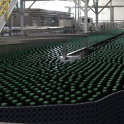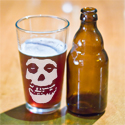|
almost posted:Appreciate the response. Do you think it would be ok to bottle something at 1.003, that was expected to go to 0.990, by keeping it 3-6°C? It's EC-1118. Do you plan on adding carbonation? From what I read you'll likely not be able to naturally carbonate with that many excess sugars.
|
|
|
|

|
| # ? Apr 27, 2024 23:14 |
|
Paladine_PSoT posted:stupid simple thing to do with this: This is ok advice but definitely do not add the yeast at 80*. Always, always, loving 100% of the time pitch your yeast strain 2-4*F below the temperature you plan on fermenting. This would solve so many homebrewers problems it boggles my mind. Those instructions aren't all that comprehensive so here we go: Dohaeris posted:2.5 Gallons You'll want to start with 2.5 gallons of water and add your honey malt in a mesh sock or nylon bag (you can get a paint strainer bag from lowes/home depot for like $3 for this) to the pot. Make sure the grains get soaked and get your temperature up to 170*, and at that point pull out the honey malt and throw it away. This process will extract all the sugars and therefore flavor out of the honey malt, and you want to pull it out at 170* because above that temperature you can extract tannins from your grain. At this point kill your heat and add half your extract, making sure to stir it in really well. Put your heat back on and get to a boil. Watch the pot carefully when it starts boiling to avoid a boilover. After you've been boiling for 5 minutes and haven't had a boilover add your Saaz and watch for a boilover again. This is your 60 minute hop addition and will give you your bitterness. After you've been boiling for 45 minutes turn the heat off and add the other half of your extract. The purpose of adding the extract late in the boil is to keep your color light, while still sanitizing the extract. Once you get back to a boil wait 5 minutes and add your Goldings, this will be your 10 minute hop addition and will provide flavor and aroma along with a little bitterness. After you're done boiling for 60 minutes kill the heat and add your lightly crushed coriander and orange peel and let it sit for 5 minutes. Now chill your wort down to 2-4*F below the temperature you plan to ferment at and transfer it all to your Mr. Beer keg and add the yeast. If you can't chill down cool enough in your pot just get it as cold as you can, transfer it to your mr. beer and stick that thing in the fridge until you get down to your pitching temperature. Ferment for 2 weeks, bottle and let it sit for two weeks and enjoy. Midorka posted:Do you plan on adding carbonation? From what I read you'll likely not be able to naturally carbonate with that many excess sugars. Is natural carbonation just letting the tail end of fermentation do the carbonating for you rather than adding some priming sugar? If so having a little bit of excess sugar is exactly what you need. Josh Wow fucked around with this message at 14:25 on Jan 19, 2013 |
|
|
|
.
almost fucked around with this message at 11:00 on Dec 15, 2013 |
|
|
|
Josh Wow posted:This is ok advice but definitely do not add the yeast at 80*. Always, always, loving 100% of the time pitch your yeast strain 2-4*F below the temperature you plan on fermenting. This would solve so many homebrewers problems it boggles my mind. What's your line of reasoning here? I typically pitch at 70-72 and cool to 64 over the next 12 hours or so and don't have any problems. I find the higher pitching temperature doesn't produce off-flavors but gets me a fast start (6-8 hours) with dry yeast.
|
|
|
|
almost posted:No, all I care about is that it be drinkable and that my bottles don't explode. I'll be putting them in 1.5L glass screw-on-cap wine bottles. How do you know it didn't stop fermentation? The only way to be sure is measuring the gravity with no change over at least 24 hours if not 48. Often times it will look like it's still fermenting due to dissolved CO2 coming out of solution and causing the airlock to bubble once every 30 seconds or so. The only safe way to bottle is to know that fermentation stopped by measuring no change in gravity. Then you can bottle carb if you want by knowing how much sugar you're adding and not end up with bottle bombs. Since you added some amount of sulfite and potassium sorbate then it's unlikely the fermentation will ever really take off again, depending on how much was added. Keeping them very cool will also slow down any potential fermentation that happens. You're probably OK doing the manual pressure release occasionally. If it is still fermenting and producing CO2 then it should just be CO2 coming out under pressure and nothing else getting in. There is of course a small risk of oxidation and contamination but if you drink it in 2 months you'll probably never notice.
|
|
|
|
Angry Grimace posted:I generally only have heard this from attempting to dry hop in active fermentation. However, dry hopping in the primary when its reaching the tail end of active fermentation is becoming very popular recently due to the belief that it prevents oxidation of the beer due to the introduction of the dry hops. Here are a few links that make me want to experiment with water profile and dry hop timing: http://inhoppursuit.blogspot.com/2012/02/more-aroma-oil-faster-dry-hopsters-holy.html http://www.themadfermentationist.com/2011/09/galaxy-hopped-double-ipa.html I pulled some samples from my sours today to see whats up. I've got 5 total gallons brewed at the end of Aug 2012, safale wheat beer yeast + cantillion/3font/hansen's/(something else I forget) dregs. After 3ish months I put 1gal onto sour cherry puree and 1gal onto sour cherry juice from the same farm and harvest. All 3 are great, the plain sour has become much less of a harsh sour and the funk is starting to show through in a nice way. Girlfriend noted a lot of sour apple. The juice gallon has a more fruit flavor, but the puree has a better tannic quality. It's all really enjoyable flat at room temp, too. A blend of the three is excellent too. Is there any easy way for me to harvest/wash some yeast and nasties from this batch so I can start another sour? ChickenArise fucked around with this message at 19:11 on Jan 19, 2013 |
|
|
|
baquerd posted:What's your line of reasoning here? I typically pitch at 70-72 and cool to 64 over the next 12 hours or so and don't have any problems. I find the higher pitching temperature doesn't produce off-flavors but gets me a fast start (6-8 hours) with dry yeast. I don't think it's necessarily going to ruin your beer but I agree with Josh. Yeast don't like to be cooled down and it could lead to poor attenuation or failure to clean up off flavors. Your process may work for you but it's just another thing you can do to stack the deck in favor of the beer turning out perfectly.
|
|
|
|
baquerd posted:What's your line of reasoning here? I typically pitch at 70-72 and cool to 64 over the next 12 hours or so and don't have any problems. I find the higher pitching temperature doesn't produce off-flavors but gets me a fast start (6-8 hours) with dry yeast. When pitching at a higher temperature it's true that the yeast start reproducing faster, but then when you cool the yeast they begin to slow down and some of them drop out completely. If you pitch lower and then let the yeast rise to your fermentation temperature you won't have yeast slowing down or dropping out and you'll have a more consistent and complete fermentation.
|
|
|
|
Interesting. I'm actually finding my beers over-attenuate if anything.
|
|
|
|
2 quick questions folks. I'm currently making a mango pale ale, it's finished primary fermentation, and I'm cooking the mango puree that I'll be putting into it for secondary fermentation: 1) The first time I made a fruit beer (an apricot wheat ale) I followed much the same process, and racked the beer onto the puree in a glass carboy. While this made good beer it was a pain in the rear end to clean; the primary vessel the beer is currently in is NOT airtight, and cannot be made airtight - can I just dump the puree in there, mix it together gently, and let the beer go through secondary fermentation in the same vessel? Or should I transfer to my carboy or another (airtight) bucket? 2) I'm planning on dry-hopping this with a couple ounces of cascade, should I wait until after secondary fermentation to do this?
|
|
|
|
baquerd posted:Interesting. I'm actually finding my beers over-attenuate if anything. Same (by a lot). I like to think it's because I make amazing yeast starters and not because I'm doing something wrong. JawKnee posted:2 quick questions folks. Yeah just dump it in there, wait for secondary fermentation to end, then add the cascade. When yeast flocculates it drags suspended hop particulates out of the beer so def wait till it calms down.
|
|
|
|
Jo3sh posted:That doesn't really turn a Sankey into a ball lock - what it does is give you a Sankey fitting with flare connections on the gas and beer connections, so you can remove the ball lock fittings from your existing lines and serve commercial beer. Ah, ok thanks guys. That doesn't seem to address my problem, then. Basically, I'm looking into buying a kegerator that is already fitted for Sankey kegs, and I want to inexpensively convert it for use with ball lock legs. If I could maintain the ability to hook up Sankey kegs too, that's fine, but it's not super important to me. Any advice you guys could provide would be great!
|
|
|
|
Mikey Purp posted:Basically, I'm looking into buying a kegerator that is already fitted for Sankey kegs, and I want to inexpensively convert it for use with ball lock legs. Oh, that's pretty easy. You just cut the Sankey fitting off and install ball lock fittings instead. Costs about $15-20 for the pair of fittings, plus whatever Cornies are going for these days. Sell the Sankey coupler on craigslist to recoup some of your costs. Voila! Single-corny kegerator. Later on, you can add more lines and more faucets if you like - you may have to swap out the tower to do that.
|
|
|
|
fullroundaction posted:Same (by a lot). I like to think it's because I make amazing yeast starters and not because I'm doing something wrong. At some point you have to start adjusting recipes to your equipment and process. If you know your beers always end up .006 points below what recipes state, start mashing 4 degrees higher or something. You can also go the other why and figure out why something's always off--maybe your thermometer is jacked up and you're actually mashing at 148 and not the 156 it reads as. But consistency is the important thing. As long as you can take a recipe and get the desired result at the end, you're doing it right.
|
|
|
|
A guy I work with is a homebrewer (and is pursuing brewing as a career) and he gave me a 6-pack of his the other day that was loving delicious. It got me wondering, if I was interested in this as a hobby, where do I start. I see the book in the OP but the OP is also several years old at this point. What equipment would I need?
|
|
|
|
Daric posted:It got me wondering, if I was interested in this as a hobby, where do I start. I see the book in the OP but the OP is also several years old at this point. What equipment would I need? Everything in the link from the OP: http://www.northernbrewer.com/shop/essential-brewing-starter-kit.html You'll also want: a 20-30L kettle, a burner powerful enough to boil at least 3 gallons of water, stirring paddle, an accurate thermometer, hydrometer, a sampling cylinder to float the hydrometer in, and bottles. Highly recommended: turkey baster/wine thief for sampling, immersion chiller, spray bottle for star-san, and whirlfloc/irish moss. You'll want to get more PBW/EasyClean/OxyClean Free and Starsan to brew more batches. You'll need more caps. You'll probably pick up a second fermenter pretty quick too if you like brewing. Edit: almost forgot, a sticky temperature strip for your fermenter. baquerd fucked around with this message at 04:30 on Jan 20, 2013 |
|
|
|
Read How to Brew by John Palmer.
|
|
|
|
baquerd posted:Everything in the link from the OP: http://www.northernbrewer.com/shop/essential-brewing-starter-kit.html I have several kettles and burners from our annual thanksgiving turkey fry we do every year. These are ok, right? I think a couple are aluminum and 1 is stainless steel.
|
|
|
|
Pots like that are fine, yes, but I would be careful about the oil residue that's almost certainly on them. For the record, either aluminum or stainless pots are great. For 5 gallon batches, a pot of about 28-32 quarts is a very very good place to start, and bigger never hurt anything either. Sounds like you probably already have a propane burner too.
|
|
|
|
Jo3sh posted:Pots like that are fine, yes, but I would be careful about the oil residue that's almost certainly on them. I might just get a new, clean pot but yeah I have several burners and a few tanks of propane already.
|
|
|
|
Jo3sh posted:Pots like that are fine, yes, but I would be careful about the oil residue that's almost certainly on them. If he already has burners he shouldn't start with less than 32 qt. in my opinion. The only reason to even bother with partial boils is impracticability. I suppose chilling the wort might be kind of lovely, though, so maybe not.
|
|
|
|
Daric posted:I might just get a new, clean pot but yeah I have several burners and a few tanks of propane already. I was very happy when I wanted to fry a turkey for the first time this past Thanksgiving and realized I already had literally every piece of hardware for the job from brewing. Just had to buy the bird and the oil. Before I did my next beer I did a thorough oxiclean scrub, filled the pot to the brim and brought it to a boil, emptied it, another oxiclean scrub, another 10gal boil, dumped the water and let it drip dry. Star-san'd it, drip dry, store until needed. Haven't seen any weird side effects in my output. Side note, the turkey was the best goddamn piece of poultry I've ever had.
|
|
|
|
Remember when using aluminum you need to boil water in it for a few minutes before use to create a layer of oxidation to prevent metallic flavors. You won't need to do it again as long as you don't scrub the layer off or take it off in some way. The layer is visible as well.
|
|
|
|
Docjowles posted:At some point you have to start adjusting recipes to your equipment and process. If you know your beers always end up .006 points below what recipes state, start mashing 4 degrees higher or something. You can also go the other why and figure out why something's always off--maybe your thermometer is jacked up and you're actually mashing at 148 and not the 156 it reads as. But consistency is the important thing. As long as you can take a recipe and get the desired result at the end, you're doing it right. Since we switched to all-grain none of our beers have finished above 1.004. I'm pretty sure we've been mashing low (tested our digital thermometer against our digital tea kettle and the results were ... confusing) and my girlfriend just smashed our primary analog thermometer yesterday so it's time for an upgrade in that department. We also ferment at ambient temps out of necessity so it's like a perfect storm for yeast to eat everything. Sam Calagione says to just use a cheap kitchen store mercury-style thermometer (which we had been using), but I know a lot of homebrewers prefer the digital probe style. Any goon go-to recommendations? Also a reminder to everyone to try to brew (at least slightly) sober. I got about a half gallon of unboiled wort dumped into my already-yeast-pitched fermenter yesterday due to everyone being hammered by noon. I'm sure the beers going to be fine, but come on [my people] get it together.
|
|
|
|
This is the most recommended around here.
|
|
|
|
Midorka posted:This is the most recommended around here. And this is it's big brother: http://www.amazon.com/Splash-Proof-...words=thermapen
|
|
|
|
Refurbs on sale: http://www.thermoworks.com/products/thermapen/splashproof_thermapen_open_box_sale_2013.html
|
|
|
|
Midorka posted:Remember when using aluminum you need to boil water in it for a few minutes before use to create a layer of oxidation to prevent metallic flavors. You won't need to do it again as long as you don't scrub the layer off or take it off in some way. The layer is visible as well. Aluminum will naturally oxidize instantly whenever it comes into contact with air. You don't have to do anything. All of my brews have been in my aluminum turkey fryer pot. It's a great piece of dual use equipment.
|
|
|
|
I want to get one of these with a Model: 113-372/373/375-T probe which is a waterproof wire probe good for -58 to 482°F Also a number of other probes for various uses.
|
|
|
|
Daric posted:A guy I work with is a homebrewer (and is pursuing brewing as a career) and he gave me a 6-pack of his the other day that was loving delicious. Everybody has some pretty good recommendations so far, but they are missing something. Let your friend know that you are looking to get into the hobby, and see if he would be willing to help you get your equipment together, or at least brew. The beer is the best part about the hobby, but the people involved are a close second.
|
|
|
|
What a brew day. Broke my hydrometer so no OG, mashed for 50 minutes instead of 60, five separate boilovers. At least my wort tasted good!
|
|
|
|
Yeah, I just finished a brew day myself with a few missteps. Last night when boiling the DME for my starter, it was near impossible to keep the stuff from vigorously foaming over. Any time I put the drat flask near the burner it wanted to jump out for dear life. It also bubbled over a bit this morning, so I probably lost a good portion of the count. Need to figure out a good solution for that. The stir plate is a new addition to my arsenal. I didn't know the boil off rate of my propane burner, so I was using BeerSmith's default of 0.5 gallons / hour. I guess I had the regulator too high, and ended up burning off almost 2 gallons. Ended up with a volume of 4.7 gallons when the target was 5.5. I measured OG at 1.061 (target was 1.056, I guess it could have been worse.) To add some mild compensation (really, wanting a bit more beer), I pitched my entire 2L starter instead of decanting like I planned. And, despite the numerous notes and warnings I had written to myself, pitched the stir bar by accident. Guess I'll need to try to sift it out of the trub when I transfer to a keg. Every brew is a learning experience though, so for next time: - Don't run the propane burner so high. A gentle roll should be sufficient. - Buy some Fermcap-S or boil the starter wort in a big rear end pot, not directly in the Erlenmeyer - Don't loving pitch the stir bar.
|
|
|
|
One of the things I love about this hobby is how I manage to do something different (read: wrong) every single time I brew. The awesome thing is I haven't had a bad beer yet and I've even managed to make some really exceptional ones! Also I just finished that quadrupel I asked about earlier; it is siphoning into the bucket as we speak. Got my best efficiency yet into the kettle (preboil gravity was 1.060, and that was before 2# of candi syrup...yikes) and the wort looks more or less like motor oil. I'm pretty excited. Thanks for the help w/ the recipe; I went to the dark syrup and cut the grain boil in half and at least as of right now it looks like both of those were excellent pieces of advice.
|
|
|
|
Kaf posted:Yeah, I just finished a brew day myself with a few missteps. You could have just added water to compensate.
|
|
|
|
Hmmm. You're right, I guess it would have been safe to do so. I'm new to all grain, so I'm still getting used to this full volume boil idea.
|
|
|
|
Galler posted:I want to get one of these with a Model: 113-372/373/375-T probe which is a waterproof wire probe good for -58 to 482°F I have one of these http://www.thermoworks.com/products/handheld/therma_k.html and adore it completely and unequivocally. +/- .5 F accuracy, which is astonishingly good. I've got the included probe which is good for some kitchen stuff, and then I have the mini needle probe (awesome for checking burger temps and things) which is submersible and fabulous, and one of the PTFE tipped probes you linked that hangs out in my mash tun or HLT while brewing. It's sort of a ridiculous amount of money to sink into a thermometer and various probes, but the Therma K is the most accurate type K thermocouple that Thermoworks makes and I brew and cook an awful lot. Worth it.
|
|
|
|
Alright, this might be a better question to ask in the bread thread, but thought I would try hear first. Anybody do any baking with fresh malt? I have a little bit of crushed crystal 30, like under a pound, I don't think I am going to be brewing anything for a while at least, so I was thinking of using that grain to make some bread. I have seen a lot of recipes involving spent grain, but what would I do with the fresh grains?
|
|
|
|
Paranoid first time brewer question. I have a milk stout racked in secondary in a glass carboy. It's about a week in and I looked at it today and noticed little white spots forming on the surface. When I looked closer I noticed on the side of the carboy there was little patches of orangish red and some of these are floating within. Is this normal? An infection? Anything at all to be concerned about?
|
|
|
|
Lots of good digital thermometer recommendations in here. I just want to say I have a Thermapen and it's probably one of my favorite kitchen gadgets, second only to my (super-cheap) digital scale. I'd originally purchased both for brewing but have since found that I'm using both of them regularly for general kitchen stuff. I'd say I'd definitely got my money's worth. The rye saison I pitched last week is finally starting to slow down. It's the first beer I've made that was actively fermenting only two hours after pitching. I'm not sure if it's the strain (3711) or the fact that it's the first time I've used a starter or both. It's been going pretty vigorously for about 5 days or so. I've got a space heater in my ferm fridge rigged to a temp controller and it seems to not have much problem keeping it in the mid/high 70s in there. It's been interesting watching the color of the beer change; it was a golden straw color before the boil, a little darker towards brown before I pitched, and now it appears a little more towards orange. This has been a really fun beer to make, hopefully it actually tastes good! I was thinking, though, if I want to throw some dregs from Orval or something else in there for some brett character, when would be the best time to do it? I've never worked with brett before. Is it something I can do way down the road, after this stuff is kegged and carbonated and I've had ample opportunity to try it and decide if it'd even be a good beer to dose? Can I pitch it right into the keg? Will there be much sediment if it referments in the keg, or would I need to rack it off to a new keg after a few months? Is a finished, carbonated beer in a keg even a decent environment for the brett to work, once it's back up to room temperature?
|
|
|
|

|
| # ? Apr 27, 2024 23:14 |
|
lifts cats over head posted:Paranoid first time brewer question. I have a milk stout racked in secondary in a glass carboy. It's about a week in and I looked at it today and noticed little white spots forming on the surface. When I looked closer I noticed on the side of the carboy there was little patches of orangish red and some of these are floating within. Is this normal? An infection? Anything at all to be concerned about? A picture would be helpful, but I am gonna go ahead and guess that your beer is fine. The next time you take a gravity sample, take a drink of the sample. If it tastes like warm flat beer, you are fine.
|
|
|

































